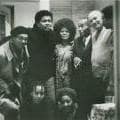The Black Arts Movement was a vibrant creative period that has had a lasting cultural impact on the East Bay.
Ever so often a social and political movement merges with an arts movement to create a uniquely vibrant environment that impacts communities for generations. The Black Arts Movement that began in 1967, and reached its zenith in the early 1980s, was such a cultural moment in this country. Two social/political movements would greatly impact the decade: African independence and American Civil Rights. As the Civil Rights Movement in America grew to gain international attention, young and creative people took an increasingly more active role. Their study and acceptance of Pan-Africanism, their identification with the words of Malcolm X and James Baldwin, and their ardent call for Black Power shifted the movement from a conciliatory call for justice to a more forceful call to political action and radical self-determination. Local artists responded by embracing African cultures, rhythms, and design motifs. This was exemplified in their dress, hairstyles, art themes, writing, and performance.
As the Black Arts Movement grew, galleries and cultural centers sprouted all over the East Bay in storefronts, church basements, and private homes. African Americans were hungry for representation, and African American artists took it upon themselves to make art that expressed what they were feeling politically and personally. People were turning away from images that demeaned the Black body and intellect, images that most had grown up absorbing. They were rejecting assimilation to the mainstream society that had maligned, repressed, and imperiled the Black community for centuries. People sought spaces to gather to create and share art and information. The cooperative spirit of the time echoed an earlier Black arts movement, the Harlem Renaissance of the 1920s.

Artists were integral to educating the African American community about their history, culture, and value to American society. They played an active part in community empowerment, and their art, in all of its variety, reflected it. Emory Douglas, Black Panther Party Minister of Culture, and Tarika Lewis (the first woman to join the Black Panther Party, using the name Matilaba) contributed art to the Black Panther newspaper, creating imagery that helped brand the group. The Bay Area Black Artists (BABA) Collective was a group that actively exhibited their works around Oakland and the East Bay during this period. This group included Carol Ward Allen, Casper Banjo, James Lawrence and mixed media artist Marie Johnson. Cartoonist Morrie Turner taught simple lessons in African American history through his "Wee Pals" characters. Many artists were also teachers such as Claude Clark, a longtime instructor at Merritt College. Artists were pushing boundaries in music, literature, and dance, too. Jazz musicians like alto saxophonist John Handy, a graduate of Oakland’s McClymonds High School, were exploring new sonic territory with free jazz. Printmaker and photographer Ted Pontiflet, a California College of Arts and Craft graduate, began his decades-long career during this time. Writers like Ishmael Reed, Reginald Lockett, J. California Cooper, and Marvin X were publishing.
Many venues showcased African American art during this period. For example, the Rainbow Sign (1971-78) on Grove Street in Berkeley was a vibrant cultural center, hosting such influential artists and thinkers as sculptor Elizabeth Catlett, singer Nina Simone, and writers Maya Angelou and James Baldwin. At the urging of African American students, Black Studies courses were being offered on and off campuses. They established Black Student Unions which provided support on college campuses and helped change the Eurocentric curriculum to a more diverse roster of courses. By the early 1970s Laney College students could enroll in Swahili and African American history courses. While activists were pushing boundaries politically with boycotts, marches, and speeches, African American artists, through visual and performative means, were also vital players in political activism. Gallery owners Samuel Fredericks, owner of Samuel’s Gallery in the old Jack London Village, and Aissatoui A. Vernita, proprietor of the Ebony Museum of Art, showcased the works of many aspiring and established artists. This groundswell of cultural expression made the Bay Area a mecca of artistic expression.
The spirit of the Black Arts Movement is still alive and well in Oakland at venues such as the Malcolm X JazzArts Festival, dance classes at the Malongo Casquelourd Center for the Arts, art openings at Joyce Gordon Gallery, The Art of Living Black annual exhibitions, and the Eastside Arts Alliance.
The Oakland Public Library can help you learn more about this culturally rich period with these books:
Encyclopedia of Hip Hop Literature
The Image of the Black in Western Art
The Black Arts Movement : literary nationalism in the 1960s and 1970s
Mounting frustration : the art museum in the age of Black power



Add a comment to: The Black Arts Movement in Oakland and Berkeley